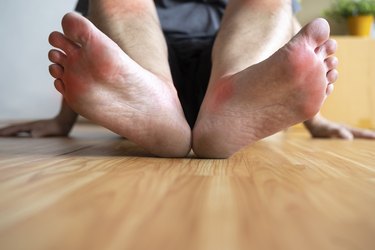
Living with neuropathy in the feet can feel like a challenge. A common complication of many chronic conditions, including diabetes, peripheral neuropathy primarily affects the nerves of the feet and can cause symptoms like pain, numbness and tingling, according to the Cleveland Clinic.
This can be very uncomfortable and even make it hard to sense where the ground is under your feet, increasing your risk for falls and balance issues, explains Steven Srebnik, PT, MSPT, a physical therapist and founder of Performance Rehabilitation.
Video of the Day
And while exercise can help manage and, in some cases, slow progression of some of these symptoms, it can be hard to get on your feet and exercise when it feels like you're walking on pins and needles.
Fortunately, these expert-approved exercises for neuropathy in the feet take all of this into account — getting blood moving through your feet and releasing tight muscles while keeping your feet comfortable, says Evan Soroka, a certified yoga therapist and the author of Yoga Therapy for Diabetes.
Read on to learn the best exercises for neuropathy in the feet and how daily movement can help you feel your best. For those experiencing neuropathy in different parts of the body, it's best to ask your doctor which moves are best for your symptoms.
Warning
Before you try any new exercises or programs, make sure to get a green light from your doctor. These exercises may not be the best moves for people living with non-diabetes-related neuropathy, so it's always best to double check.
Move 1: Ball Rolling
- Stand behind a chair with a lacrosse ball or tennis ball in hand.
- Place the ball on the ground and put both hands on the back of the chair for balance.
- Place the inner arch of your right foot on the ball.
- Roll the ball across your arch to the middle of your foot, to the outer edge of your foot.
- Repeat this pattern on your right foot for a minute or two.
- Switch feet.
Tip
You can add or take away pressure from the massage depending on how much weight you put on the ball, Soroka says. Don't have a lacrosse ball? Try Kieba Massage Lacrosse Balls for Myofascial Release (Amazon.com, $15.75).
If standing is too much pressure, you can also do this one seated.
Move 2: Ankle Roll
- Sit on the edge of a chair with your feet planted on the floor.
- Cross your right ankle over your left knee.
- Roll your ankle in a counter-clockwise direction.
- After about 30 seconds, switch directions.
- After you complete 60 seconds on your right ankle, switch sides.
After 12 weeks of gait training and ankle range-of-motion exercises (like the moves above and below), subjects living with diabetes-related peripheral neuropathy saw better overall movement and minimized pain, according to a May 2022 study in Scientific Reports.
Move 3: Foot Point and Flex
- Sit on the floor with your legs extended straight in front of you.
- Point your toes away from your body.
- Hold here for a few breaths.
- Reverse the motion and point your toes towards you as far as is comfortable.
- Alternate for about 60 seconds.
Tip
If sitting on the floor feels uncomfortable, you can do this move on a couch or place a pillow on the ground under your feet.
Move 4: Calf Roll
- Sit on the floor with your right leg fully extended, left knee bent with your left foot on the floor.
- Place a tennis ball or lacrosse ball under your right calf.
- Put your hands on the ground behind you.
- Using your hands for balance, roll the ball up and down the length of your calf, pausing on tight spots.
- Roll your right calf for 60 seconds, then switch sides.
Move 5: Lower Leg Circles
- Lay on the ground with your knees bent, feet flat on the floor.
- Raise your right leg, taking hold behind your thigh.
- Straighten your knee as much as is comfortable.
- Rotate your ankle in a clockwise direction.
- As you rotate, bend and straighten your knee slowly.
- After 30 seconds, switch directions of your ankle rolls.
- After 60 seconds, switch sides.
6 Benefits of Exercise for Neuropathy in the Feet
1. It Can Help Control Blood Sugar
Diabetes is a common cause of peripheral neuropathy, and for anyone with diabetes, exercise is an important part of effective neuropathy treatment, according to The Foundation for Peripheral Neuropathy. It explains that uncontrolled blood sugar levels can speed the progression of peripheral neuropathy.
Fortunately, being physically active helps to control blood sugar levels, which can in turn help your symptoms.
2. It Can Relieve Muscle Pain
Workouts like yoga can help reduce the muscle cramps and relieve the muscle pain that's often associated with neuropathy, Joseph Palmer, DPT, OMPT, a physical therapist and co-owner of Active Life & Sports PT says. And if you're especially struggling with discomfort in your feet, some lower-body stretches may be able to help.
Although there's no cure for this condition, exercise does not necessarily increase risk of foot ulcers and pain in people with diabetes-related neuropathy. On the contrary, exercise can actually help improve symptoms and potentially reduce pain, according to a January 2017 article published in the Journal of the American Physical Therapy Association.
3. It Can Build Muscle and Balance
Muscle loss and weakness is a common symptom of peripheral neuropathy. That's especially true in your feet, ankles and legs. That's one area where exercise comes in, helping build strength and balance, according to Srebnik.
Peripheral neuropathy in the feet can increase your risk of falls and injury, as the nerve damage in your feet can make it difficult to stay balanced. But building strength and stability can help keep you injury-free.
4. It May Improve Nerve Health
In some cases, exercise may even help improve nerve health. For people living with diabetes-related neuropathy in the feet, exercise may help improve nerve function and reduce pain and numbness, Srebnik says.
5. It Can Reduce Stress
Exercise is a great way to manage stress, too, according to the Mayo Clinic. While managing your mental health might not nix your symptoms, it can help you deal with them in more productive, healthy ways — which can bode well for every aspect of your health.
6. It Can Encourage Better Sleep
For those who experience painful neuropathy in the feet, getting restful sleep can be a challenge. Moving your body each day can actually help promote better sleep, according to the Mayo Clinic. Not only does exercise tire you out but thanks to its stress-reducing benefit, it can help you get some more restful shut eye.
How to Exercise With Neuropathy in the Feet
When it comes to working out with neuropathy, it's best to follow a physical therapist- or doctor-recommended treatment plan, Palmer says. Most often, a treatment plan may include stretching and balance exercises, aerobic exercise and strength training.
When getting moving, focus on exercises that don't put much pressure on your feet. For low-impact cardio, recumbent biking and walking are both good choices that tend not to cause issues. And when strength training, steering clear of plyometric exercises can help keep your feet happy. Choose seated exercises if you're having a flare-up or difficulty standing.
Additional reporting by Bojana Galic.
- Cleveland Clinic: "Neuropathy (Peripheral Neuropathy)"
- The Foundation for Peripheral Neuropathy: "Improve Treatment Discover a Cure"
- Mayo Clinic: "Exercise and Stress: Get Moving to Manage Stress"
- Journal of the American Physical Therapy Association: "Physical Training and Activity in People With Diabetic Peripheral Neuropathy: Paradigm Shift"
Is this an emergency? If you are experiencing serious medical symptoms, please see the National Library of Medicine’s list of signs you need emergency medical attention or call 911.


